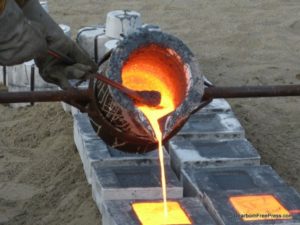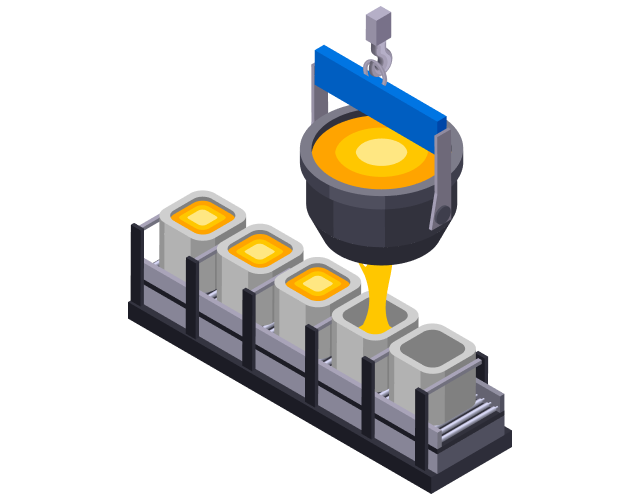Comprehending the Metal Castings Process: A Comprehensive Guide for Beginners
The Metal Casting procedure is a fundamental strategy in making that transforms molten steel right into solid forms. Newbies need to realize the different methods entailed, such as sand casting and die spreading. Comprehending the materials, style principles, and precaution is similarly crucial. Each aspect plays an important role in accomplishing successful outcomes. As one navigates these details, the concern of just how to maximize each action for enhanced outcomes ends up being significantly significant.
The Basics of Steel Casting
Although Metal Casting has developed over centuries, its basic principles continue to be essential and regular to the manufacturing process. At its core, Metal Casting involves the transformation of molten steel into solid objects through various methods. The process starts with the production of a mold, which defines the shape of the end product. As soon as the mold and mildew is prepared, metal is heated to its melting point and put right into the dental caries. After cooling, the metal solidifies, taking the shape of the mold and mildew.
There are a number of casting approaches, including sand spreading, financial investment casting, and die casting, each with distinct advantages and applications. The option of method depends on aspects such as manufacturing volume, product type, and wanted accuracy. When cast, the end product might undertake extra processes like machining or surface area therapy to achieve the required coating and requirements. Recognizing these essentials is essential for any individual interested in the area of Metal Casting.

Recognizing Materials Utilized in Steel Casting
Products play a vital duty in the Metal Casting procedure, affecting the end product's buildings and performance. Different steels are utilized, including aluminum, bronze, steel, and iron, each offering unique qualities suited for particular applications. Light weight aluminum is corrosion-resistant and lightweight, making it suitable for vehicle parts. Iron, particularly cast iron, is preferred for its excellent wear resistance and toughness. Steel gives high toughness and flexibility, usually utilized in heavy machinery elements. Bronze, understood for its corrosion resistance and machinability, is frequently utilized in aquatic applications.
Along with the metals, numerous casting products, such as sand, plaster, and ceramic, are made use of to create molds. Sand casting, the most common method, utilizes silica sand as a result of its thermal security and capacity to create detailed forms. Plaster and ceramic molds offer finer details however might need even more intricate processes. The selection of materials straight affects the performance, cost, and high quality of the casting operation.
The Design Refine: From Principle to Blueprint
The layout process in Metal Casting starts with the initial principle advancement, where concepts are produced and assessed. This is adhered to by the application of CAD modeling strategies, enabling precise visualizations of the style. The blueprint finalization actions assure that all specs are properly documented for production.
Preliminary Concept Advancement
Initial idea growth marks a crucial phase in the Metal Casting procedure, where concepts transform right into substantial styles. During this stage, developers team up with engineers and stakeholders to brainstorm and refine initial principles. They think about variables such as capability, aesthetics, and manufacturability, guaranteeing that the style meets the required specifications and performance criteria. Sketches and outlines are developed to envision the ideas, permitting preliminary assessments of usefulness and cost-effectiveness. This phase also involves determining products and prospective casting approaches that straighten with the layout objectives. Ultimately, preliminary principle advancement prepares for a complete blueprint, guiding the subsequent phases of the casting procedure and guaranteeing a successful change from idea to truth.
CAD Modeling Techniques
Changing principles right into accurate styles, CAD modeling methods play a crucial function in the Metal Casting process. These methods make use of sophisticated software application to develop in-depth three-dimensional versions that properly mirror the desired item. By employing devices such as parametric modeling, strong modeling, and surface area modeling, developers can manipulate dimensions and forms with convenience. CAD systems additionally promote simulation and evaluation, permitting the recognition of prospective imperfections prior to manufacturing begins. This positive technique reduces material waste and maximizes the design for manufacturability. Furthermore, CAD designs can be quickly customized, making it possible for fast iterations based upon responses. Essentially, CAD modeling works as the backbone of the layout procedure, linking the gap in between initial concepts and the ultimate production-ready layouts.
Blueprint Finalization Steps
Adhering to the production of comprehensive CAD designs, the next stage involves plan completion, which is important in converting electronic designs right into workable plans for production. This procedure starts with evaluating the CAD models for accuracy and conformity with specs. Once validated, the dimensions, resistances, and material specifications are diligently outlined to guarantee clearness. Including notes and notes aids interact essential info pertaining to casting processes, surface area coatings, and setting up demands. The finalized blueprint undertakes a strenuous authorization procedure, typically including cooperation with engineers and manufacturing teams to attend to any possible problems. After all alterations are made and authorizations acquired, the plan is formally released, functioning as the fundamental document for the subsequent phases of Metal Casting, including pattern making and mold and mildew design.
The Metal Casting Strategies Described

Metal Casting methods encompass a selection of techniques used my link to form liquified steel YOURURL.com into wanted forms. These techniques vary according to the kind of material, intricacy of the style, and manufacturing quantity. Sand casting is one of one of the most common approaches, involving the development of a mold from sand to hold the molten metal. Financial investment spreading, or lost-wax casting, enables detailed layouts by utilizing a wax pattern that is dissolved. Die casting employs high-pressure shot of liquified metal into a mold and mildew, suitable for mass manufacturing. Other methods consist of permanent mold and mildew casting, which utilizes recyclable mold and mildews, and centrifugal casting, where rotational pressures assist in loading the mold. Each strategy has its benefits and applications, making it essential for producers to pick the appropriate approach based on their particular needs and requirements. Comprehending these techniques is important for anyone associated with the Metal Casting procedure.
Finishing Processes: Enhancing Your Casted Item

Finishing procedures play an essential role in improving the top quality and look of casted products. Different surface therapy strategies, such as sprucing up and finish, are utilized to boost longevity and looks. Additionally, high quality examination methods guarantee that the last product satisfies defined standards and performance needs.
Surface Area Therapy Strategies
A variety of surface area treatment methods play a vital duty in improving the quality and durability of casted products. These strategies consist of approaches such as shot blasting, polishing, and finishing. Shot blowing up efficiently gets rid of surface flaws, enhancing the useful and aesthetic characteristics of the spreading. Sprucing up offers a smooth surface, which is specifically crucial for decorative applications and elements needing marginal friction. Finishing techniques, such as electroplating or powder finish, offer additional protection against rust and wear, ensuring toughness. In addition, surface area treatments can enhance attachment for subsequent processes, such as painting or bonding. By employing these techniques, manufacturers can achieve superior surface high quality, which is important for the efficiency and lifespan of Metal Casting in different applications.
High Quality Examination Approaches
Efficient high quality examination approaches are vital for ensuring the stability and performance of casted items after the finishing processes. Various methods are used to assess the quality of Metal Casting, including visual examination, dimensional checks, and non-destructive testing (NDT) Visual examination permits for the recognition of surface problems, while dimensional checks guarantee that items fulfill defined tolerances. NDT methods, such as ultrasonic screening and radiographic assessment, provide deeper insights right into interior stability without harming the castings. In addition, mechanical screening, such as tensile and firmness tests, examines material buildings - Metal Castings. By using a mix of these techniques, makers can improve product quality and dependability, eventually leading to higher consumer complete satisfaction and lowered production prices
Security Considerations in Metal Casting
While the Metal Casting procedure provides numerous advantages, it also provides a variety of security dangers that should be carefully handled. Employees in casting facilities are revealed to heats, liquified metals, why not look here and harmful materials, which can cause extreme injuries if proper safety measures are not taken. Individual safety devices (PPE) such as heat-resistant handwear covers, face shields, and safety clothes is vital to minimize dangers.
Furthermore, the presence of fumes and dust requires correct air flow systems to guarantee air high quality - Metal Castings. Regular training on security protocols is necessary for all staff members to identify prospective risks and react effectively. Emergency situation procedures need to be established, consisting of fire safety and security procedures and initial aid accessibility. Upkeep of tools and correct handling of products better add to a more secure working environment. By focusing on these security factors to consider, Metal Casting procedures can protect their labor force and keep effective manufacturing processes
Frequently Asked Concerns
What Are the Environmental Impacts of Metal Casting?
Metal Casting can lead to environmental influences such as air and water contamination, source depletion, and power consumption. In addition, inappropriate waste administration and discharges from factories add to ecological disruptions and health risks for nearby areas.
Just how Do I Select the Right Metal for Casting?
To choose the appropriate steel for casting, one must think about aspects such as mechanical residential properties, rust resistance, thermal conductivity, and cost. Examining the intended application and ecological conditions is necessary for perfect choice.
What Are the Usual Flaws in Metal Casting?
Common flaws in Metal Casting consist of porosity, shrinkage, sand addition, and misruns. These problems often occur from inappropriate product option, poor style, or defects in the casting process, affecting the end product's top quality and efficiency.
How Can I Boost My Metal Casting Abilities?
To boost Metal Casting abilities, one should practice constantly, research spreading methods, examine previous jobs for problems, seek comments from seasoned wheels, and continually experiment with different products and methods to boost efficiency and understanding.
What Is the Cost of Beginning a Metal Casting Organization?
Starting a metal casting company normally calls for a first financial investment of $5,000 to $50,000, depending upon tools, products, and facility expenses. Elements like area and range can greatly influence overall startup costs.
The Metal Casting procedure is a fundamental strategy in manufacturing that transforms molten metal right into solid types. Beginners have to understand the various approaches included, such as sand casting and pass away spreading. There are a number of casting methods, including sand spreading, investment casting, and die spreading, each with one-of-a-kind advantages and applications. Investment spreading, or lost-wax casting, enables for intricate layouts by utilizing a wax pattern that is thawed away. Various other methods consist of long-term mold and mildew spreading, which uses reusable molds, and centrifugal casting, where rotational forces aid in filling up the mold.